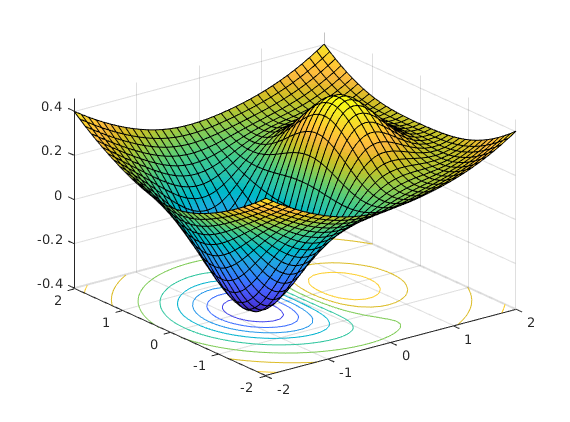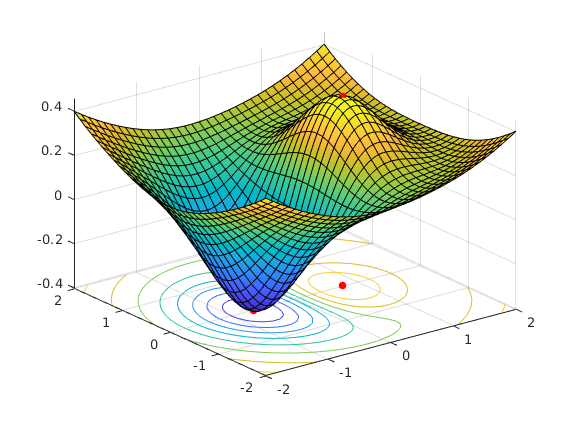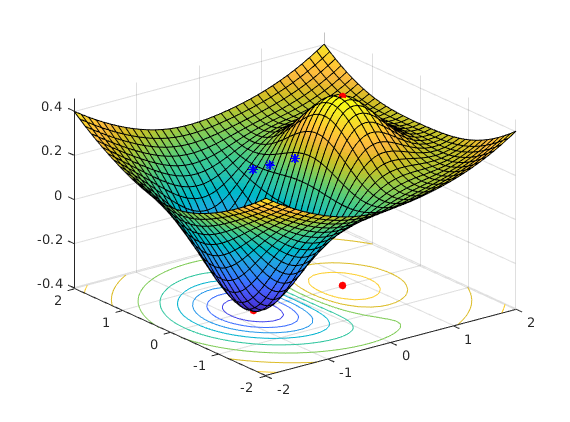minmax2dsolver2.m
Solutions to assignment 4 (b).
Contents
- Unconstrained Optimization Example
- a) Just use min/max for matrix elements (no fancy methods):
- fminsearch: Matlab's optimization function
- Basic use of fminsearch and tic-toc-timing:
- max(f(x) = - min(-f(x))
- Which is better?
- Run fminsearch with 200 x 200 = 40000 initial points.
- How many lead to a minimum value?
- How many are close to minval?
- Which are "far"?
- Q: Which init. pts. lead to these "far points"?
- Change for to parfor
close all format compact
Unconstrained Optimization Example
Consider the problem of finding the minimum/maximum of the function:

Plot the function to get an idea of where it is minimized
f = @(x,y) x.*exp(-x.^2-y.^2)+(x.^2+y.^2)/20; fsurf(f,[-2,2],'ShowContours','on')

a) Just use min/max for matrix elements (no fancy methods):
tic x=linspace(-2,2,200); y=x; % 200x200 grid [X,Y]=meshgrid(x,y); z=f(X,Y); [minvala,mininda]=min(z(:)); Ta=toc % Ta = 7.000000000000000e-04
Ta =
0.0022
[maxvala,maxinda]=max(z(:)); % Find max as well. minpta=[X(mininda),Y(mininda),minvala] % Use linear indexing. maxpta=[X(maxinda),Y(maxinda),maxvala] % --- " --- hold on % Mark min- and max-points in the picture: plot3(X(mininda),Y(mininda),minvala,'.r','Markersize',20) % rotate to see plot3(X(maxinda),Y(maxinda),maxvala,'.r','Markersize',20) plot3(X(maxinda),Y(maxinda),-0.4,'.r','Markersize',20) % Projection on xy-plane
minpta =
-0.6734 -0.0101 -0.4052
maxpta =
0.7538 -0.0101 0.4554

fminsearch: Matlab's optimization function
fminsearch wants fun to have one vector input instead of (x,y). (Compare with Globalmin, where we did just vice versa.)
fun = @(x) f(x(1),x(2));
Basic use of fminsearch and tic-toc-timing:
tic
x0=[0 0] % See figure.
[xminb,fminvalb]=(fminsearch(fun,x0))
Tb=toc
x0 =
0 0
xminb =
-0.6690 0.0000
fminvalb =
-0.4052
Tb =
0.0070
max(f(x) = - min(-f(x))
[xmaxb,fmaxvalb]=(fminsearch(@(x)-fun(x),x0));fmaxvalb=-fmaxvalb
fmaxvalb =
0.4555
Which is better?
format long [minvala fminvalb] [maxvala fmaxvalb] %{ ans = -0.405171103703264 -0.405236869193178 ans = 0.455427624902720 0.455466872171926 Tb = 0.002690000000000 %} % Accuracy slightly better with b) (fminsearch) (5 th digit on) % Timing better with a) Ta_over_Tb=Ta/Tb % ans = % 0.266542750929368 % % Timings vary from run to run (Ta is smaller or a lot smaller) %
ans = -0.405171103703264 -0.405236869193178 ans = 0.455427624902720 0.455466872171926 Ta_over_Tb = 0.317122014018023
Run fminsearch with 200 x 200 = 40000 initial points.
The problem with optimization programs is the starting point. Take 40000 starting points and see how many lead (close) to min. This is a task suitable for parallel computation.
Repeat some commands from above:
%%%%%%%%%%%%% Begin copy %%%%%%%%%%%% f = @(x,y) x.*exp(-x.^2-y.^2)+(x.^2+y.^2)/20; x=linspace(-2,2,200); y=x; % 200x200 grid [X,Y]=meshgrid(x,y); z=f(X,Y); fun = @(x) f(x(1),x(2)); %%%%%%%%%%%%%%%%% End copy %%%%%%%%%%% tic [m,n]=size(X); X1=X(:);Y1=Y(:); z=zeros(3,m*n); for k=1:m*n [x,val]=(fminsearch(fun,[X1(k) Y1(k)])); z(:,k)=[x';val]; % k^th column: [x(1);x(2);f(x(1),x(2))] end Tc=toc % Tc = 78.3867
Tc = 75.879069000000001
How many lead to a minimum value?
fvals=z(3,:); minval=min(fvals) [min(fvals) max(fvals)]
minval = -0.405236870252235 ans = -0.405236870252235 0.231461818471495
How many are close to minval?
nr_close=sum(abs(fvals-minval)<.0001) nr_all=length(fvals) ratio=nr_close/nr_all
nr_close =
39994
nr_all =
40000
ratio =
0.999850000000000
Which are "far"?
Logindclose=abs(fvals-minval)<.0001; Farind=~Logindclose; %z([Farind;Farind;Farind]) x=z(1,:);y=z(2,:);mins=z(3,:); Farpoints=[z(Farind);y(Farind);mins(Farind)] plot3(Farpoints(1,:),Farpoints(2,:),Farpoints(3,:),'*b')
Farpoints = Columns 1 through 3 -0.000005152622828 -0.405236868470644 -0.669078383945737 -0.012968039845456 0.012968039845456 -0.010420664583319 0.231461315085067 0.231461315085067 0.231461818471495 Columns 4 through 6 0.000028166297804 -0.405236870091823 -0.669064070351759 0.010420664583319 -0.010656774944354 0.010656774944354 0.231461818471495 0.231461775245993 0.231461775245993

Q: Which init. pts. lead to these "far points"?
It is easy to pick those strating points, but let's leave it now. General consideration along these lines: "Basin of attraction", Optimization toolbox documentation.
Change for to parfor
Measure tic-toc-timing difference especially on Triton. (parfor uses all available (24) workers.)